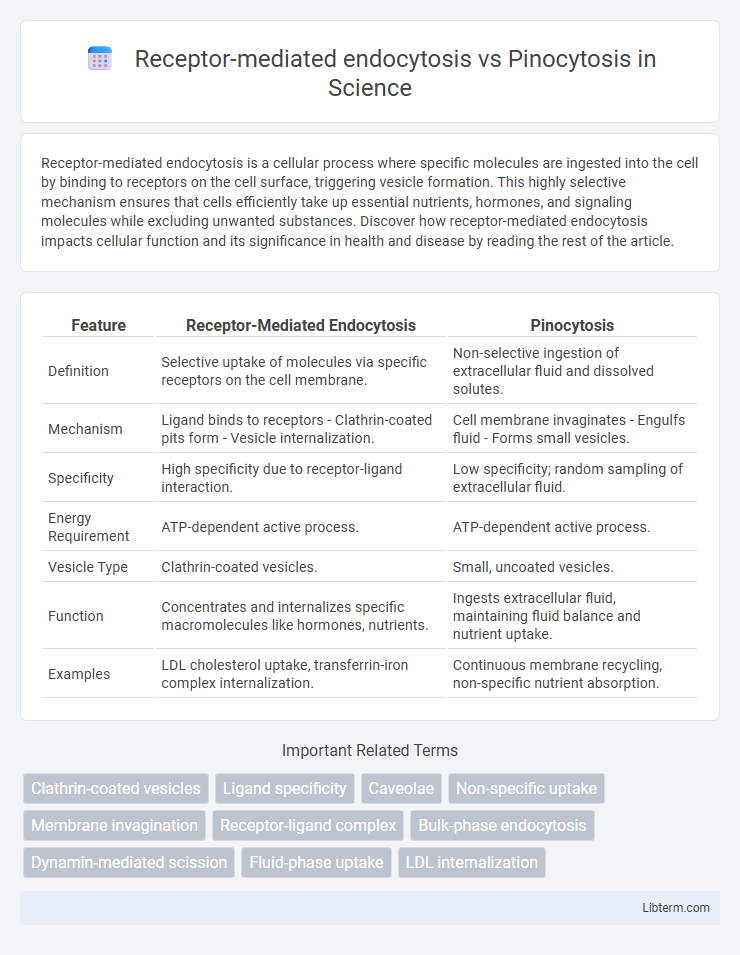Receptor-mediated endocytosis is a cellular process where specific molecules are ingested into the cell by binding to receptors on the cell surface, triggering vesicle formation. This highly selective mechanism ensures that cells efficiently take up essential nutrients, hormones, and signaling molecules while excluding unwanted substances. Discover how receptor-mediated endocytosis impacts cellular function and its significance in health and disease by reading the rest of the article.
Table of Comparison
| Feature | Receptor-Mediated Endocytosis | Pinocytosis |
|---|---|---|
| Definition | Selective uptake of molecules via specific receptors on the cell membrane. | Non-selective ingestion of extracellular fluid and dissolved solutes. |
| Mechanism | Ligand binds to receptors - Clathrin-coated pits form - Vesicle internalization. | Cell membrane invaginates - Engulfs fluid - Forms small vesicles. |
| Specificity | High specificity due to receptor-ligand interaction. | Low specificity; random sampling of extracellular fluid. |
| Energy Requirement | ATP-dependent active process. | ATP-dependent active process. |
| Vesicle Type | Clathrin-coated vesicles. | Small, uncoated vesicles. |
| Function | Concentrates and internalizes specific macromolecules like hormones, nutrients. | Ingests extracellular fluid, maintaining fluid balance and nutrient uptake. |
| Examples | LDL cholesterol uptake, transferrin-iron complex internalization. | Continuous membrane recycling, non-specific nutrient absorption. |
Introduction to Endocytosis Processes
Endocytosis involves cellular uptake of external substances through membrane invagination, with receptor-mediated endocytosis specifically recognizing ligands via cell surface receptors for targeted internalization, enhancing specificity and efficiency. Pinocytosis, often called "cell drinking," nonspecifically engulfs extracellular fluid and dissolved solutes, allowing bulk uptake without receptor involvement. These processes facilitate nutrient acquisition, regulation of membrane composition, and signal transduction crucial for cellular homeostasis.
Definition of Receptor-Mediated Endocytosis
Receptor-mediated endocytosis is a selective cellular process where specific molecules bind to receptors on the cell surface, triggering the invagination of the plasma membrane to form a vesicle that internalizes the bound substances. This mechanism ensures efficient uptake of essential molecules such as hormones, nutrients, and signaling proteins. Unlike pinocytosis, which involves non-specific fluid-phase uptake, receptor-mediated endocytosis relies on receptor-ligand recognition for specificity and regulation.
Understanding Pinocytosis
Pinocytosis is a form of endocytosis where cells engulf extracellular fluid and dissolved solutes non-specifically through small vesicles, enabling nutrient uptake and membrane recycling. Unlike receptor-mediated endocytosis, pinocytosis does not require ligand-receptor binding for vesicle formation, resulting in a continuous and non-selective internalization process. This mechanism plays a crucial role in maintaining cellular homeostasis and sampling the extracellular environment.
Mechanisms of Receptor-Mediated Endocytosis
Receptor-mediated endocytosis involves the selective uptake of specific molecules through ligand binding to cell surface receptors, triggering the invagination of clathrin-coated pits. This mechanism enables cells to internalize nutrients, hormones, and signaling molecules efficiently by concentrating ligands in vesicles formed via dynamin-mediated membrane scission. The process is tightly regulated by adaptor proteins like AP-2, which link receptors to clathrin, ensuring specificity and control over endocytic cargo selection.
Mechanisms of Pinocytosis
Pinocytosis involves the non-specific uptake of extracellular fluid and solutes through the invagination of the plasma membrane, forming small vesicles that transport fluids into the cell. It operates via various mechanisms such as clathrin-independent endocytosis, micropinocytosis, and macropinocytosis, which differ in vesicle size and regulatory proteins involved. Unlike receptor-mediated endocytosis, pinocytosis does not rely on ligand-receptor binding, allowing cells to continuously sample their environment for nutrients and signaling molecules.
Key Differences Between Receptor-Mediated Endocytosis and Pinocytosis
Receptor-mediated endocytosis selectively internalizes specific molecules through receptor-ligand interactions, resulting in vesicles enriched in target substances, whereas pinocytosis non-selectively engulfs extracellular fluid and solutes without receptor involvement. The former utilizes clathrin-coated pits for vesicle formation, enabling high specificity and efficiency, while the latter involves membrane invaginations without specialized coat proteins, leading to bulk uptake. Receptor-mediated endocytosis plays a critical role in nutrient uptake and signaling, contrasting with pinocytosis's role in general fluid sampling and maintaining cellular homeostasis.
Biological Significance and Functions
Receptor-mediated endocytosis enables selective uptake of specific molecules such as hormones, nutrients, and antibodies by binding them to cell surface receptors, ensuring targeted nutrient acquisition and signal transduction. Pinocytosis involves non-specific engulfment of extracellular fluid and dissolved solutes, facilitating fluid balance and nutrient sampling across cell membranes. Both processes maintain cellular homeostasis, support nutrient uptake, and regulate membrane composition but differ in specificity and molecular regulation mechanisms.
Examples of Molecules Involved
Receptor-mediated endocytosis involves specific molecules such as clathrin, adaptins, and cargo-specific receptors like LDL receptors that bind to low-density lipoproteins for selective uptake. In contrast, pinocytosis is a nonspecific process that internalizes extracellular fluids and solutes without the need for receptors, primarily involving actin and dynamin to facilitate vesicle formation. Both processes utilize cytoskeletal elements and membrane proteins but differ significantly in molecular specificity and cargo recognition.
Advantages and Limitations of Each Process
Receptor-mediated endocytosis offers high specificity and efficiency by selectively internalizing molecules via ligand-receptor interactions, enabling targeted uptake of essential nutrients and signaling molecules; however, its limitation lies in receptor saturation and energy dependence. Pinocytosis allows nonspecific uptake of extracellular fluid and solutes, facilitating bulk-phase internalization and continuous membrane recycling, but it lacks specificity and often results in lower efficiency for selective molecule absorption. Both processes play essential roles in cellular function, with receptor-mediated endocytosis optimizing selectivity and pinocytosis providing a more generalized uptake mechanism.
Summary and Future Perspectives
Receptor-mediated endocytosis is a highly selective cellular process that involves specific ligand-receptor interactions leading to the internalization of molecules, whereas pinocytosis is a non-selective uptake of extracellular fluid and solutes. Advances in molecular imaging and nanoparticle design are enhancing the understanding and manipulation of these pathways for targeted drug delivery and therapeutic interventions. Future research will likely focus on optimizing receptor specificity and endosomal escape mechanisms to improve clinical outcomes in disease treatment.
Receptor-mediated endocytosis Infographic

 libterm.com
libterm.com